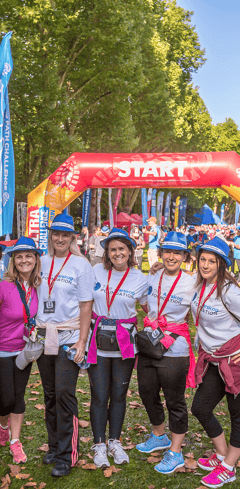The fitter you feel on the morning of your walk the more confident you will be in your ability to reach the finish line – and the more you will enjoy it.
Only you will know your current fitness level – and where you would like your overall general level of fitness to be. Increasing your stamina will mean your recovery time after longer walks are reduced and that you aren’t out of breath if your walk involves hill climbing. Building up your muscles in your legs too will also mean you can cope with up and downhill terrain whilst carrying a rucksack on your back.
 Nutrition & hydration
Nutrition & hydrationA camel pack/hydration bladder is a great way of keeping yourself hydrated as you can sip little and often – it is something you need to focus on to ensure you stay healthy and don’t become dehydrated.
The majority of people who pull out of long distance walks do so as a result of blisters. Here' some tips from long distance walking expert Brian Smailes on keeping your feet blister free:
• Change Your Socks Regularly! Ensure you take plenty walking socks for the event both thin and thicker ones. If you are prone to getting blisters, then change socks every 10 - 15 km to keep your feet dry.
• Choose Your Footwear Carefully & Check the Weather: Always check the weather – if it is going to be very hot your feet will swell and sweat, making the likelihood of developing blisters much higher. If it rains, you will need a waterproof boot.
• Blister Treatment: Don’t wait until you get a blister to treat it – prevention is better than a cure! If you feel a warm spot or a part of your foot that is rubbing, stop and put a blister plaster on, ensuring your feet are dry before you apply it.
• Tape Up Your Feet! Many people who are prone to blisters tape up their feet/toes and any known hot spots prior to a long walk, with zinc oxide tape which is available at most sports shops. There are many online videos which give you a guide.

8 Weeks Before
o Get some new boots and your footwear sorted!
o Set out and aim to achieve two 10 minute walks per week
o Set out how you will exercise at least 2 times a week until the walk
6 Weeks Before
o You should have walked at least 5km in one go aiming for a pace of 3kph
o You should be walking at least 3 times a week for 20 mins or more
4 Weeks Before
o You should have walked at least 10km in one go at a pace of 4kph
o Wear your backpack for the walk, and any kit you plan on wearing on the event
2 Weeks Before
o By now you should have walked at least 15km in one go at a pace of 4kph
o Have all the kit required from the walk and know your socks/blister prevention
1 Week Before
o Ease off the training – give your feet a rest
o Have a quiet week – no late nights!
o Enjoy a week of lots of pasta & carbs!

Our mission is simple – to transform and connect business through next generation IT infrastructure. Complemented by strategic relationships with some of the world’s leading technology partners, Cisilion now serves a global client base across more than seventy countries.
Terms & Conditions© 2025 Cisilion. All Rights Reserved..